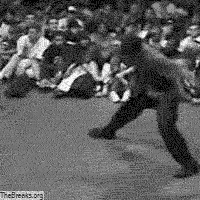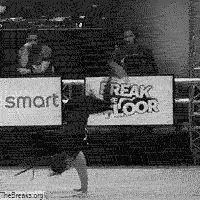Airflare, or air twist, power move, a rotating hop from a handstand, with the torso angled away from vertical.
History
The airflare was developed by Paulo around 1989 . Transmission of the move was aided by Storm and Swift Rock's B-Boying 1 & 2, released in 1993 on VHS, which included film of Paulo performing, from standing, an airflare to windmill in 1989 . The move may have been influenced by a move done by Icey Ice in the early 1980s called the air move, resembling a half airtrack into ninja freeze (visible in e.g. The Big Breakdance Contest ). During the early 1990s, the move was done mainly in Europe (e.g. by Storm and Swift Rock), where it was called the air twist . For example, Swift Rock was recorded in 1991 while in New York performing an airtrack, catching on his hands, and transitioning into footwork. At the Battle of the Year in 1995, Thunder executed an airtrack 1.5 (freezing on his back) and Ibrahim a flare into airtrack (freezing on his chest).
Inspired by videos from Europe, members of Soul Control began integrating the airflare into combos in late 1995 . Kujo relates that "there were several people that we saw do it for the first time. The first person we saw in person do airflare was Ivan, but we had also seen Paulo from Holland do it, on video" . An early video of Battle Squad and other Europeans reached Soul Control via Easy Rock on which, Kujo recalls in particular, a black b-boy "did flare, and then spun in the air, and then caught, and then went to like half a windmill out of it" —da Silva speculates that this was Ibrahim , who indeed performed precisely this combination during practice in December 1995 . Kujo performed an airtrack to windmill in the music video for Jason Nevins' version of "It's Like That," filmed in December 1997 . Pablo Flores developed continuous airflares in 1998, and could be seen doing them at Freestyle Session 3 in November of that year . Benny Kimoto and Tuff Kid also developed and helped popularize the airflare around this time—notable were the "Ultimate Battle" between Basel City Attack and Soul Control at Ultimate B-Boy Session Special in December 1998, and Benny's flare into eight consecutive airflares at Freestyle Session 4 in 1999. According to Kujo, "Benny came to our garage in 1997 and flipped out at the shit we were doing. He did do some basic airflare combinations concurrently with us, but definitely not what Pablo did. We all knew each other at this time" . Some of Soul Control's airflare combinations could be seen in their battle against Kaiten Club in 1998; Kaiten Club's Stove would have multiple airflare combinations by 1999. The first to execute consecutive airflares in South Korea was Sunghoon, slightly before the Korea Cup World Hip Hop Festival held in August 1999 . For Sunghoon, Ivan was his initial inspiration to learn airtrack to windmill; accomplished in 1997 . It was only after seeing Benny's airflares—he refers to Benny's form as a true ("진정한") airflare, on a different level than Ivan ("아이반과는 차원이 다른") —that he developed the move further. Later in 1999, at Freestyle Session 5 Moy performed six airflares into two flares, as well as an airflare 1.5 from the opposite hand . Also that year, in a battle between Rock Force and The Family in Rotterdam multiple breakers used the move or variations. The airflare continued to be developed in the late 1990s and early 2000s primarily in California, France, South Africa, South Korea, and Texas. Ruen, Nightcrawler, Boy, and Blond are notable for pioneering early variations. Shie-chan became the first b-girl with airflares in 2002 .
Where airflares advanced in the 1990s tended to have communities already focused on power combinations. In fact, airflares would remain almost exclusively in rounds consisting of toprock and a single power combo until the developments of Ruen, Moy, Benny, Tuff Kid, and others in the early 2000s. Kujo mentions the influence of "the old Cali style. You know, 1992, 1995, that era. It's all about long combos. Like, you remember Jazzy J, he would do just forever combos. Jazzy J wasn't the only one. There were a lot of people doing that, and Megaman and Charles and Pablo were three of the best at that. Gerald from Rock Force was another one" . A member of Sidewalk Breakers was even filmed performing an airflare-like move around 1984 —while this does not appear to have influenced the move's later development, it reflects the milieu in which power developed in California. In Texas, Oliver of United B-Boys estimates that in the mid-1990s, "everybody had power, or at least someone in their crew that had like, ridiculous power" . The 1998 Beats and Pieces shows Logo executing an early combo containing flare to two airflares to windmill, filmed at the Majic Skating Rink . Logo has claimed that he performed continuous airflares in 1997 . Other breakers from Texas would include Nightcrawler, Moy, Boy, Omar, and Milky. In Brazil, São Paulo and Goiânia had breakers similarly focused on power. Kokada recalls first seeing an airflare done by a b-boy from Goiânia . Da Silva presents a video of Kokada doing a round of flare, two airflares, three flares, a forearm airflare, then two flares in 1997 . Earlier film of Kokada shows him executing high hopping flares and low airflares in 1995 (the venue was Espaço Sideral in Itaim Paulista), suggesting a possible pathway for the move's development. Substantiating these early dates to some extent, there is film of Careca performing continuous airflares by August 1998 . The high visibility of California and Europe in the late 1990s and the subsequent appearance of South Korea in international settings attenuated the perceived influence of other regions.
Variations
In addition to the variations below, airflares can be done with different forms (e.g. swing-based, kick-based, more or less piked ).

Airchairflare
Also chair airflare. Airflare starting from an airchair.
Airflare 1.5
Also airflare bomb. Airflare with a 540° rotation, landing on one's back. Done by Ibrahim in 1998 and Nightcrawler in 1999 .
Airtrack
Also low airflare, star track, no-leg swipe. Airflare with the body nearly horizontal. Originally, Kujo and Ivan distinguished airtracks from airflares by specifying that airtracks rotate about only a single axis (i.e. the move is thrown and caught in a similar position) .
Elbowtip Airflare
Also elbow airflare. Airflare on the tips of the elbows. Done by Omar in 2003 .
Elbowtrack
Also elbow airflare. Airflare on the forearms. Done by Speedy in 1996 and Inferno in 1997 , though for Kujo, Babak was "the first guy to ever do it on his elbow, back in 1995" .
Elbow-to-Hand Airflare
Also flash airflare. Airflare starting on the elbow and caught on the hand of the opposite arm.
Elbow Up Airflare
One-elbow airflare caught instead on the hand.
Hopping Airflare
Airflare with hops from hand to hand, omitting the momentary handstand in the standard airflare. Developed by Ruen, and independently by Blond by 2000 . Blond called them time-difference (시간차) airtracks .
Lotus Airflare
Airflare with legs in the lotus position.
Munch Airflare
Also baby airflare. Airflare with legs tucked into the chest and kicked out during the hop, as in a munchmill. Done by Ruen in 2000 .
One-Hand Airflare
Also one-arm airflare. Airflare caught on the throwing hand.
One-Elbow Airflare
One-Hand Airflare on the elbow. Done by Boy in 2000 .
Tombstone Airflare
Also pike airflare, feet-together airflare. Airflare with legs piked, as in a tombstone. Developed by Ruen by 2000 .
Toe-Touch Airflare
Airflare where, after catching on one arm, the other arm touches one's toes on the same side. Done by Ruen in 2000 .
Traveling Airflare
Also walking airflare, moving airflare. Airflare that moves laterally. Developed by Blond by 2002 .
Two-Hand Airflare
Airflare where both arms leave and return to the ground simultaneously.
Tucked-Leg Airflare
Airflare where the leg on the side of the throwing arm is bent at the knee. Done by Blond in 2002 .
Walkovers
Also no-fly airflare. Airflare where at least one hand always remains on the ground. Developed by Strech and Rubber in 2001 , then popularized by Riaan and Brahim.
